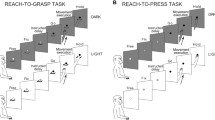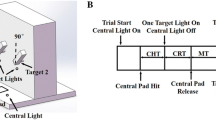Abstract
This study was designed to investigate how activity patterns of primary motor cortical (MI) neurons change when monkeys perform the same movements guided by somatosensory and/or visual cues. Two adult male rhesus monkeys were trained to make wrist extensions and flexions after holding a steady position during an instructed delay period lasting 0.5–2.0 s. Monkeys held against a 0.07 Nm load that opposed flexion movements. Wrist movements were guided by vibratory cues (VIB-trials), visual cues (VIS-trials), or both in combination (COM-trials). Extracellular recordings of 188 MI neurons were made during all three paradigms. Individual neurons were counted twice, once for each movement direction, yielding 376 cases. All neurons had significant task-related activity (TRA) changes relative to delay period activity during at least one of the three paradigms. TRA was analyzed to determine if it was different as a function of the sensory cue(s) that initiated movement and that specified movement endpoints. Cases were grouped by whether the TRA changes were greater in VIB- or VIS-trials; this defined their “bias”. One hundred and eighteen cases (31.4%) had greater TRA changes in VIB-trials (Vb-neurons), whereas 185 (49.2%) showed greater TRA changes in VIS-trials (Vs-neurons). The remaining 73 cases (19.4%) had similar TRA changes in VIB- and VIS-trials (Nb-neurons). For Vb- and Vs-neurons, earlier TRA onsets and greater TRA changes were observed in the trials for which these neurons were biased. During the COM-trials, the TRA was intermediate. During the trials for which the activity was not biased, the TRA was the least. For Nb-neurons, no significant TRA differences were observed across paradigms. TRA changes of MI neurons may represent movement planning-related inputs from other central, presumably cortical, sources as well as contribute to motor outflow from the cortex. These data suggest that Vb- and Vs-neurons are affected differently by somatosensory- and visually related central inputs, resulting in different TRAs, even for essentially identical movements. Such differences may depend not only on the type of sensory information that initiates movement but also whether that information specifies movement endpoints or might interfere with movement monitoring.










Similar content being viewed by others
References
Alexander GE, Crutcher MD (1990a) Preparation for movement: neural representations of intended direction in three motor areas of the monkey. J Neurophysiol 64:133–150
Alexander GE, Crutcher MD (1990b) Neural representations of the target (goal) of visually guided arm movements in three motor areas of the monkey. J Neurophysiol 64:164–178
Andersen RA, Snyder LH, Bradley DC, Xing J (1997) Multimodal representation of space in the posterior parietal cortex and its use in planning movements. Ann Rev Neurosci 20:303–330
Ashe J, Georgopoulos AP (1994) Movement parameters and neural activity in motor cortex and area 5. Cereb Cortex 4:590–600
Bütefish CM, Khurana V, Kopylev L, Cohen LG (2004) Enhancing encoding of a motor memory in the primary motor cortex by cortical stimulation. J Neurophysiol 91:2110–2116
Colburn TR, Evarts EV (1978) Long-loop adjustments during intended movements: use of brushless DC torque motors in studies of neuromuscular function. In: Desmedt JE (ed) Progress in Clinical Neurophysiology, vol IV. Karger, New York, pp 153–166
Colby CL, Duhamel JR (1996) Spatial representations for actin in parietal cortex. Cognit Brain Res 5:105–115
Cox DR, Lewis PAW (1966) The statistical analysis of series of events. Chapman and Hall, London, pp 54
Evarts EV (1986) Motor cortex output in primates. In: Jones EG, Peters A (eds) Cerebral cortex. Plenum Press, New York, pp 217–241
Fetz EE, Finocchio DV, Baker MA, Sojo MJJ (1980) Sensory and motor responses of precentral cortex cells during comparable passive and active joint movement. J Neurophysiol 43:1078–1089
Fogassi L, Gallese V, Fadiga L, Luppino G, Matelli M, Rizzolatti G (1996) Coding of peripersonal space in inferior premotor cortex (area F4). J Neurophysiol 76:141–157
Gandolfo F, Li C, Benda BJ, Schioppa CP, Bizzi E (2000) Cortical correlates of learning in monkeys adapting to a new dynamical environment. Proc Natl Acad Sci USA 97:2259–2263
Gentilucci M, Fogassi L, Luppino G, Matelli M, Camarda R, Rizzolatti G (1988) Functional organization of inferior area 6 in the macaque monkey. I. Somatotopy and the control of proximal movements. Exp Brain Res 71:475–490
Graziano MSA, Gandhi S (2000) Location of the polysensory zone in the precentral gyrus of anesthetized monkeys. Exp Brain Res 135:259–266
Graziano MS, Hu XT, Gross CG (1997) Visuospatial properties of ventral premotor cortex. J Neurophysiol 77:2268–2292
Graziano MS, Reiss LA, Gross CG (1999) A neuronal representation of the location of nearby sounds. Nature 397:428–430
Hauk O, Johnsrude I, Pulvermüller F (2004) Somatotopic representation of action words in human motor and premotor cortex. Neuron 41:301–307
Hernández A, Zainos A, Romo R (2002) Temporal evolution of a decision-making process in medial premotor cortex. Neuron 33:956–972
Holdefer RN, Miller LE (2002) Primary motor cortical neurons encode functional muscle synergies. Exp Brain Res 146:233–243
Jackson A, Gee VJ, Baker SN, Lemon RN (2003) Synchrony between neurons with similar muscle fields in monkey motor cortex. Neuron 38:115–125
Jones EG, Wise SP (1977) Size, laminar and columnar distribution of efferent cells in the sensory-motor cortex of monkeys. J Comp Neurol 175:391–438
Kakei S, Hoffman DS, Strick PL (2003) Sensorimotor transformations in cortical motor areas. Neurosci Res 46:1–10
Kargo WJ, Nitz DA (2003) Early skill learning is expressed through selection and tuning of cortically represented muscle synergies. J Neurosci 23:11255–11269
Karni A, Meyer G, Jezzard P, Adams MM, Turner R, Ungerleider LG (1995) Functional MRI evidence for adult motor cortex plasticity during motor skill learning. Nature 377:155–158
Karni A, Meyer G, Rey-Hipolito C, Jezzard P, Adams MM, Turner R, Ungerleider LG (1998) The acquisition of skilled motor performance: fast and slow experience-driven changes in primary motor cortex. Proc Natl Acad Sci USA 95:861–868
Kurata K, Tanji J (1986) Premotor cortex neurons in macaques: activity before distal and proximal forelimb movements. J Neurosci 6:403–411
Lamarre Y, Busby L, Spidalieri G (1983) Fast ballistic arm movements triggered by visual, auditory, and somesthetic stimuli in the monkey. I. Activity of precentral cortical neurons. J Neurophysiol 50:1343–1358
Lebedev MA, Denton JM, Nelson RJ (1994) Vibration-entrained and premovement activity in monkey primary somatosensory cortex. J Neurophysiol 72:1654–1673
Lemon R (1984) Methods for neuronal recording in conscious animals. In: IBRO Handbook Series: methods in the neurosciences, vol IV. Wiley, Chichester
Li CS, Padoa-Schioppa C, Bizzi E (2001) Neuronal correlates of motor performance and motor learning in the primary motor cortex of monkeys adapting to an external force field. Neuron 30:593–607
Liu Y, Denton JM, Nelson RJ (2000) Premovement activity in monkey precentral cortex differs when somatosensory and visual cues specify movement end points. Soc Neurosci Abstr 26:180
Lu XF, Ashe J (2005) Anticipatory activity in primary motor cortex codes memorized movement sequences. Neuron 45:967–973
Merchant H, Battaglia-Mayer A, Georgopoulos AP (2004) Neural responses in motor cortex and area 7a to real and apparent motion. Exp Brain Res 154:291–307
Moran DW, Schwartz AB (1999) Motor cortical representation of speed and direction during reaching. J Neurophysiol 82:2676–2692
Naito E, Roland PE, Ehrsson HH (2002) I feel my hand moving: a new role of the primary motor cortex in somatic perception of limb movement. Neuron 36:979–988
Nelson RJ (1988) Set related and premovement related activity of primate primary somatosensory cortical neurons depends upon stimulus modality and subsequent movement. Brain Res Bull 21:411–424
Nelson RJ (1996) Interactions between motor commands and somatic perception in sensorimotor cortex. Curr Opin Neurobiol 6:801–810
Nelson RJ, McCandlish CA, Douglas VD (1990) Reaction times for hand movements made in response to visual versus vibratory cues. Somatosens Mot Res 7:337–352
Nelson RJ, Smith BN, Douglas VD (1991) Relationships between sensory responsiveness and premovement activity of quickly adapting neurons in areas 3b and 1 of monkey primary somatosensory cortex. Exp Brain Res 84:75–90
Nelson RJ, Liu Y, Denton JM (1999) Premovement sensorimotor cortical neuronal activity differs with cues that specify target location. Soc Neurosci Abstr 25:152
Paz R, Boraud T, Natan C, Bergman H, Vaadia E (2003) Preparatory activity in motor cortex reflects learning of local visuomotor skills. Nat Neurosci 6:882–890
Poliakov AV, Schieber MH (1999) Limited functional grouping of neurons in the motor cortex hand area during individuated finger movements: a cluster analysis. J Neurophysiol 82:3488–3505
Rizzolatti G, Scandolara C, Matelli M, Gentilucci M (1981) Afferent properties of periarcuate neurons in macaque monkeys. II. Visual responses. Behav Brain Res 2:147–163
Salinas E, Romo R (1998) Conversion of sensory signals into motor commands in primary motor cortex. J Neurosci 18:499–511
Schieber MH, Hibbard LS (1993) How somatotopic is the motor hand area? Science 261:489–492
Shen L, Alexander GE (1997) Neural correlates of a spatial sensory-to-motor transformation in primary motor cortex. J Neurophysiol 77:1171–1194
Sober SJ, Sabes PN (2003) Multisensory integration during motor planning. J Neurosci 23:6982–6992
Sober SJ, Sabes PN (2005) Flexible strategies for sensory integration during motor planning. Nat Neurosci 8:490–497
Sun HJ, Campos JL, Chan GSW (2004) Multisensory integration in the estimation of relation path length. Exp Brain Res 154:247–254
Tanji J (1994) The supplementary motor area in the cerebral cortex. Neurosci Res 19:251–268
Tanji J, Kurata K (1982) Comparison of movement-related activity in two cortical motor areas of primates. J Neurophysiol 48:633–653
Vaadia E, Kurata K, Wise SP (1988) Neuronal activity preceding directional and nondirectional cues in the premotor cortex of rhesus monkeys. Somatosens Mot Res 6:207–230
Wise SP, Boussaoud D, Johnson PB, Caminiti R (1997) Premotor and parietal cortex: corticocortical connectivity and combinatorial computations. Ann Rev Neurosci 20:25–42
Wise SP, Moody SL, Blomstrom KJ, Mitz AR (1998) Changes in motor cortical activity during visuomotor adaptation. Exp Brain Res 121:285–299
Zhang J, Riehle A, Requin J, Kornblum S (1997) Dynamics of single neuron activity in monkey primary motor cortex related to sensorimotor transformation. J Neurosci 17:2227–2246
Acknowledgements
We thank Drs. D.L. Armbruster and R.S. Waters for detailed comments of this manuscript. This work was supported by NIH Grant NS36860 to R.J. Nelson. Y. Liu was partially supported by a Neuroscience Postdoctoral Fellowship Award, University of Tennessee.
Author information
Authors and Affiliations
Corresponding author
Rights and permissions
About this article
Cite this article
Liu, Y., Denton, J.M. & Nelson, R.J. Neuronal activity in primary motor cortex differs when monkeys perform somatosensory and visually guided wrist movements. Exp Brain Res 167, 571–586 (2005). https://doi.org/10.1007/s00221-005-0052-8
Received:
Accepted:
Published:
Issue Date:
DOI: https://doi.org/10.1007/s00221-005-0052-8




